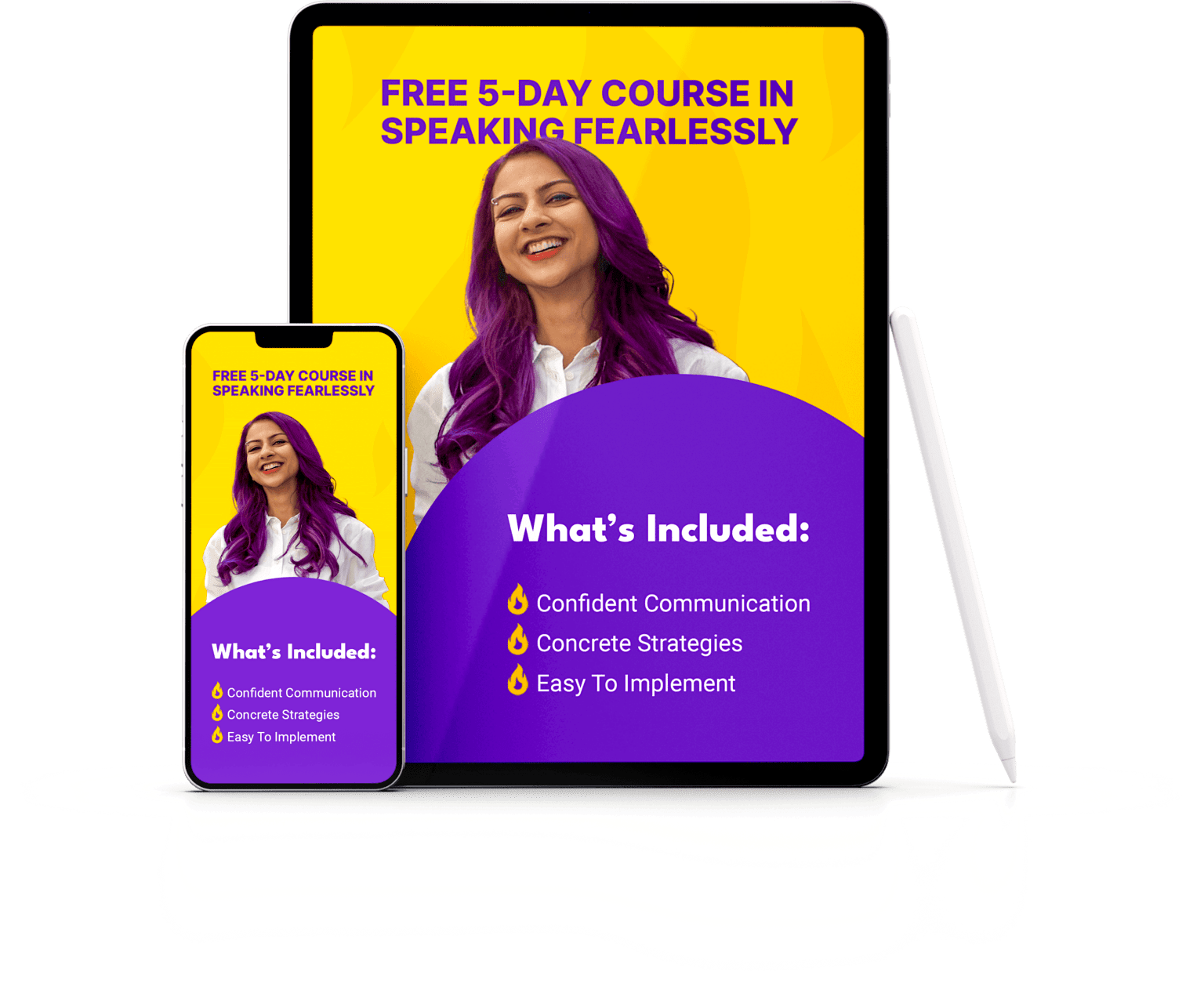As an entrepreneur building your personal brand – you can’t afford to be invisible:
You have to come out from behind the keyboard and step out of the shadows if you want to grow your business.
You have to get on that podcast, present at that conference, lead that big client meeting.
But that’s not your zone of genius. Or even your zone of comfort.
You’re convinced that you’d much rather check your spam folder and reply to that prince in need of a financial intermediary than be on that stage or on camera.
However, the truth is that whether you’re pitching to investors, addressing your team, or presenting at industry conferences, the ability to communicate with confidence and impact is a game-changer.
So whether you’re an entrepreneur who doesn’t know where to start with public speaking or who wants to practice speaking skills but your schedule looks like a tetris game – this is for you.
Table of Contents

Photo by ThisisEngineering RAEng on Unsplash
Overcoming Common Public Speaking Challenges for Busy Entrepreneurs
1. Time Constraints
Your schedule is always crazy.
Don’t wait for a calmer period to improve your speaking skills. That calmer period may (unfortunately) never come. And while you wait – you’ll still be getting into important meetings you need to speak at, presenting at important events or speaking at high stakes podcasts.
The key is to focus on targeted and efficient practice.
Identify key speaking engagements and dedicate specific time slots for preparation. This way you’ll have clear goals and timelines to work on – especially if you work well under pressure of timelines.
Once you have a clear goal – e.g. to speak at a specific conference, treat it like a project. Schedule it in, add prep slots to your calendar and make sure you’re setting time aside for both content creation as well as delivery practice.

Photo by Jason Goodman on Unsplash
2. Mindset
Just because you’re an expert in your industry doesn’t mean you can talk about it effectively.
For a lot of entrepreneurs who know their industry inside out, this might be a rude awakening.
The good news is – once you adopt a learning mindset, you can acquire the tools you need to express your ideas, expertise and vision with ease.
3. Fear of Public Speaking
A lot of clients ask me – “Nausheen, how can I stop feeling the nerves before I go on stage or on camera?”
The best response is – you can’t eliminate your nerves. They’re a natural part of the experience. But you can learn to reframe them. The fascinating thing to note here is that the body produces the same physiological response for both nerves as well as excitement. It’s then up to the brain to label that emotion. We can essentially train our brain to think of nerves as excitement – change the self-talk from “I’m so nervous that I’ll mess up” to “I’m really excited to do well”.
In addition, you can also learn to relax before big talks using techniques like deep breathing and visualization to manage anxiety.

4. Crafting Engaging Content Quickly
As a busy entrepreneur, speaking engagements are often a lose-lose:
If it’s a prepared presentation, you often don’t have time to put it together.
If it’s improvised speaking – e.g. on a podcast – you often feel underprepared and ill-at-ease articulating your thoughts when you’re under the spotlight.
You can use content organization frameworks to help you out in both situations. These frameworks help you quickly organize your thoughts and ideas – whether you’re structuring a presentation or coming up with a response to a question on the fly. Here are three content frameworks you can try:
- Hook – flesh – conclude: Start with a strong opening statement or claim. Flesh it out using clear points supported by examples, and end with a strong and impactful conclusion.
- Rule of 3s: Organize your thoughts or ideas into groups of 3 – this helps the audience follow along and retain your points better.
- Start late – end early: When telling a story, for example, start in the middle of the action instead of slowly easing your audience into it. This is a great way to get them hooked. And then aim to end early without dragging on the conclusion so that the audience is left wanting more.
5. Balancing Authority and Approachability
A number of us make this mistake unknowingly when speaking: we become too pedantic or condescending without meaning to be. When we share how to do something, we come across as know-it-alls. When we share a story of our success, we might be perceived as being too arrogant.
Aim to become more aware of how you’re being perceived and then find the balance between projecting authority and approachability. Your audience should perceive you as a knowledgeable expert who is also relatable. This relatability is not just a “nice to have” – people buy from people they genuinely like and relate to. Be perceived as the expert who has gone through similar challenges as your audience, and is sympathetic and willing to share.

Photo by Henri Mathieu-Saint-Laurent
Practical Strategies for Mastering Public Speaking
1. Keep it Audience Centric
Focusing on the audience first is a win-win: First, you can combat any self-doubt (or imposter syndrome!) by telling yourself that you’re there to serve your audience. And secondly, this mindset will help you structure your ideas and presentation, always keeping the audience in mind.
Adopting this mindset might mean:
- You speak to the audience as if you’re having a one-on-one conversation with a friend or a client.
- You ask more questions if it’s a live audience so that they can remain engaged.
- If it’s an “imagined” audience – like on a podcast or a standalone video – you use your tone and vocabulary to make them feel like they’re right there, having a conversation with you.
2. Invest in Skill Development
Remember how we talked about being an expert doesn’t always mean you have the skills to communicate your expertise? Consider enrolling in public speaking courses or working with a public speaking coach. These investments in skill development pay back tenfold in enabling you to enhance your ability to convey your ideas persuasively and with impact.
Building a strong speaking toolkit means mastering your voice, refining your body language and tapping into a more active, energetic version of yourself. And more than that- it means cultivating your presence so that you always show up as the most impactful version of yourself when you speak on any platform.
3. Record Yourself
Don’t just practice your talk in front of a mirror. It’s highly unnatural – you won’t be able to fully focus on your speaking skills if you’re feeling too self-conscious about how you look and appear. This also doesn’t give you any data to review and analyze later. Lose-lose.
Instead, make it a habit to record yourself rehearsing or practicing responses to anticipated questions. Watch yourself back and note your micro-level speaking skills: Were you speaking with energy? Were you modulating your voice and using pauses? How was your body language?
This method not only lets you formulate a strategy to improve your speaking skills with each recording – but it also forms the habit of giving yourself feedback, which is crucial in your growth as a public speaker.

Photo by Harry Cunningham on Unsplash
4. Put in that practice
Don’t fall into the trap of “I’ll wing it”.
That’s a hit or miss scenario. You leave your success up to how well you’ll be able to “wing it” without practicing that particular day. This level of inconsistency doesn’t increase your trust in your ability to deliver. So you end up always feeling nervous or anxious as you can’t predict how your performance is gonna turn out.
Eliminate unpredictability in your performance on camera or on stage by putting in the work in practicing your talk. Or, if you don’t have a presentation to deliver, prep for that podcast or live event by practicing responses to anticipated questions.
I have a rule of thumb for all my clients: whatever time you have to prepare for your speaking engagement – aim to spend at least 50% of that time rehearsing and practicing your delivery.
5. Become an informed consumer
The next time you watch a TED talk, or even see an actor deliver a great performance: don’t just watch it like a consumer. Watch it like a fellow speaker and performer. Note the tricks and techniques that the speaker or performer is using. Are they being expressive with their hand gestures? Are they varying the pitch of their voice to match the content and keep us engaged? How good are they at managing their micro expressions and do we notice them?
Becoming an “informed” consumer means you can use your time consuming any kind of media as a low-key learning activity, making mental notes of new techniques that you can apply to your own speaking.

Me delivering my first TEDx talk! You can watch it here.
Integrating Public Speaking into a Busy Schedule
1. Incorporate Speaking Opportunities Strategically
A number of entrepreneurs make one of two mistakes when they start speaking in public:
- They either start accepting invites to every single podcast, every single event – even if the reach for these opportunities is low.
- OR – they are too selective and only want to get into higher profile events, or they want to get paid for every single speaking opportunity.
The truth is – neither approach is optimal. If you accept every single opportunity to speak, it will quickly become a drain on your time and won’t have a significant impact on your business.
But if you only wait for the bigger opportunities, or only pitch to top 10 podcasts and events – you are likely to get frustrated with their lack of interest (unless you happen to be an influencer!)
Aim to strike a balance: pitch to both medium and high profile podcasts and events, and say yes once in a while to a lower-stakes opportunity so that you can practice your speaking skills “in the wild”.
2. Redefine “public speaking”
Once you learn how to become a strong speaker, aim to practice your speaking skills in every room or Zoom.
Reframe “public speaking” for yourself – every time you speak to an audience of more than 1 person, you are speaking in public. This way, you don’t need to wait for a formal speaking opportunity or a tall wooden podium to practice how to be a strong and impactful speaker.

3. Embrace Informal Opportunities
Find opportunities to talk within your regular schedule.
At your next team meeting, create and deliver a 2-3 minute talk about a key learning.
During your next client meeting, share a list of 3-5 insights that you can build on.
Start more impromptu discussions with team members – while staying relevant and productive.
Use these improvised, carved-out speaking opportunities to practice key skills that you’re learning, in a lower-stakes environment that still puts you under the spotlight.
These moments provide valuable practice in articulating your thoughts on the go with clarity.
5. Speak at networking events
Find opportunities to speak at different kinds of low-key events: networking events, coffee shop storytelling events, open mics etc. These events offer a less stressful environment to practice speaking skills – while still offering the “healthy” stress of being present live with an audience.
Leveraging Public Speaking for Entrepreneurial Success
1. Crafting a Compelling Origin Story
Develop your “origin story” – a story of why you do what you do. Talk about your journey to entrepreneurship – encapsulating the events that led you to what you’re doing now, and the kinds of results and goals you have for your business. Origin stories get people excited about our business and makes them feel like they have a stake in our success.
A simple but effective way of structuring your origin story is:
- Background and setting the stage: Start with the “before” state – share what life was like before you got the itch to become an entrepreneur and launch your business.
- Call to adventure: Include your call to adventure – an event that was the trigger for you to explore entrepreneurship.
- Challenges and obstacles: Talk about what kinds of challenges you faced after you decided to launch your business -initial failures or successes that helped you grow, evolve and pivot.
- Turning point: Pinpoint where you felt your luck changing – what was the biggest or most meaningful turning point in your entrepreneurial journey that has led you to make big changes or led you to where you are now?
- Impact and significance: Share with us some key results and successes that you experienced after your turning point. End with a vision of the future and what achieving that dream goal means for you.
This might sound a bit long or complicated – but the best origin stories are simple and precise. Each segment doesn’t need to be equally long either. I recommend that you spend less time on the first two steps and flesh out the challenges and turning points as the most exciting parts of the story.

2. Effective Use of Visuals
Gather all photos of you and the team to use in your talk.
Commission photo shoots so you can document your journey.
Develop and record new videos showing behind-the-scenes for what you do.
Use these photos and videos in your next presentation or live event. Share your screen and show them in your next podcast. Think of what you can use to bring your story, ideas and knowledge to life.
3. Interactive Engagement
So many speakers make this mistake: they treat a presentation or even a podcast like it’s a one-way conversation. That becomes boring fast.
Audiences don’t want to be talked at. They want to be engaged with. This means you have to proactively include opportunities for your live audience to speak up and participate.
And if you have an audience you can’t interact with (like on a podcast, for example), you will need to engage them using your speaking tools – using intonations in your voice so they can follow along better instead of being monotonous. Pose questions to them even if you can’t hear their responses. Let them know how they can engage with you after watching the podcast – and then take time to respond to queries.

These folks look pretty bored. Don’t be that speaker.
Public speaking opportunities for entrepreneurs
When you want to start speaking in public, you can start anywhere. Seek out new opportunities and pitch to industry events. Balance out lower profile, lower stakes events with high profile opportunities. You can use the lower stakes events to practice your speaking skills and the higher profile opportunities to get more visibility for your brand and your business.
Here are a few ideas to get you started:
- Ask your clients if they’re up for a 60 minute talk that you can craft for their teams/departments/companies. This might be paid or unpaid but it will help you reach a wider audience in a space where you have at least one advocate and ally.
- Look up storytelling open mic events near you – these might be happening right in your neighborhood without you knowing. They’re a great space to practice your speaking skills in a lower-stakes environment. (And you can practice that origin story you’ve been working on!)
- Look up medium to high-profile industry events – both online and in person – and pitch yourself as a speaker.
- Register yourself on speaker bureaus, add “Speaker” to your LinkedIn profile and consider asking around for any public speaking opportunities. This will alert your network that you’re open to speaking opportunities.
- Look up top 100 podcasts in your industry and pitch to a selection of the top, medium and lower profile ones (relatively speaking!) on the list.
- Aim to do a LinkedIn Live event by yourself or in collaboration with a trusted friend or colleague. This will help ease the anxiety of speaking at a live event and will help you articulate your thoughts with ease. If a video event gives you too much anxiety, start with a LinkedIn audio event where you don’t even need to turn the camera on.

Mastering public speaking is not only achievable for you as a busy entrepreneur but also crucial in ensuring you keep leveling up as an entrepreneur and personal brand. If most of your peers are busy writing LinkedIn text posts, then speaking in public, at live events and on podcasts will set you apart.
Your potential clients will get a much richer experience if they see you speak vs reading your social media posts. Sharing clips of your speaking engagements can help you directly attract prospective clients for your business. By addressing common challenges, incorporating practical strategies, and leveraging the power of a well-written origin story, entrepreneurs can elevate their public speaking skills and, in turn, propel their businesses to new successes.
With strategic practice and the right mindset in place, public speaking is absolutely a skill that you can master. Want to become a more powerful speaker in 2024? Let’s talk.



